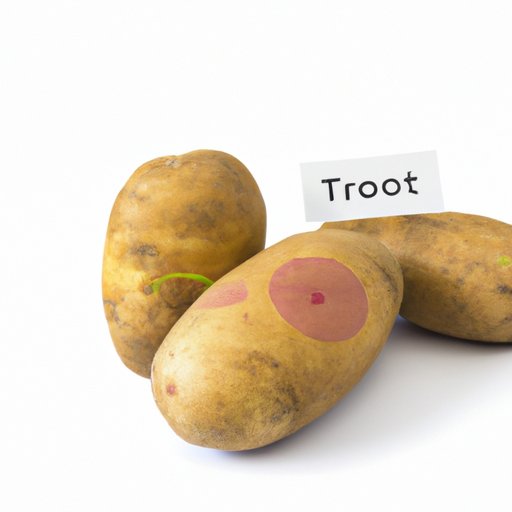
Introduction
As one of the most widely consumed foods in the world, potatoes are a staple in many households. Knowing how to identify bad potatoes is crucial to avoid consuming spoiled food and keep your family safe from potential illness. In this article, we’ll provide a comprehensive guide on how to identify bad potatoes, how long they can be stored, and what to do with them to prevent waste.
A Guide to Identifying Bad Potatoes
One of the easiest ways to identify if potatoes have gone bad is by looking for visible signs of spoilage. The following are some common signs to look for:
- Browning and discoloration on the skin and flesh
- Sprouting from the eyes and skin
- Soft spots or wrinkles on the surface
- A foul odor or smell
Each of these signs can indicate different stages of spoilage. Browning and discoloration, for example, can be caused by excessive exposure to light or air, while sprouting is a natural process that signifies the potato is no longer fresh. Soft spots and wrinkles are a result of bacteria growth and decay, while foul odor indicates advanced spoilage. Below, we’ll explain each sign in further detail.
Browning and Discoloration
Browning and discoloration on the skin or flesh of a potato is a sign that it has been exposed to either too much light or air. This can happen during storage or transportation and can cause the potato to deteriorate quickly over time. Potatoes with brown spots or discoloration are safe to eat, but those that have extensive brown areas should be avoided.
Sprouting
When potatoes start to sprout, it’s a sign that the potato is no longer fresh. However, the sprouts themselves are not harmful and can be easily removed. Sprouts are caused by the eyes of a potato and are a natural part of the potato’s life cycle, but they can cause the potato to taste bitter.
Soft Spots or Wrinkles
Soft spots or wrinkles on the surface of a potato are a sign of decay and bacterial growth. If a potato has these signs, it should be discarded immediately. These areas are a perfect breeding ground for bacteria that can cause illness if consumed.
Foul Odor
If your potato has an unpleasant, foul odor, it is a sign that it has gone bad and should be discarded immediately. The smell is caused by bacterial growth and can cause illness if consumed.
How Long Can Potatoes Safely be Stored and How to Tell if They Have Gone Bad
The shelf life of potatoes depends on how they are stored and at what temperature. The following is a timeline of how long potatoes can be stored depending on the storage method:
- In a pantry or cabinet at room temperature: 1 to 2 weeks
- In a refrigerator: 3 to 4 weeks
- In a cool and dark root cellar: 2 to 3 months
- In a freezer: up to 6 months
The best way to tell if a potato has gone bad is by looking for any of the aforementioned signs, particularly soft spots or wrinkles. If the potato has become slimy or developed a bad odor, it is best to throw it away to avoid risk of illness.
What to Do with Bad Potatoes: Avoiding Waste and Preventing Spoilage
If you have potatoes that have gone bad, don’t just throw them in the trash. There are several ways to avoid waste and prevent spoilage. One option is to compost the potatoes, which will break down the organic material and turn it into nutrient-rich soil. Another option is to feed the potatoes to animals, such as chickens or pigs, who will appreciate the treat.
To prevent spoilage in the first place, it is important to store potatoes properly. Keep them away from direct sunlight and in a cool, dark place. Potatoes should be stored in a breathable container, such as a mesh or paper bag, to allow for air circulation. Avoid storing potatoes near onions, as they can release gases that cause the potatoes to spoil faster.
The Science Behind Potato Spoilage
Potato spoilage is a result of chemical and biological processes that cause the breakdown of nutrients that the potato needs to sustain itself. Once a potato has been harvested, it no longer receives the nutrients it needs from the plant and begins to break down. Bacteria and fungi can also cause spoilage by breaking down the sugars in the potato and producing waste products that cause the potato to rot.
Sorting Potatoes: Tricks of the Trade
When selecting potatoes, there are a few tricks you can use to choose the best quality potatoes. Look for potatoes that are firm and free of any soft spots or wrinkles. Avoid potatoes with any sprouts, as these indicate that the potato is no longer as fresh. When sorting through potatoes, be sure to remove any that show signs of spoilage to prevent further spoilage in the rest of the batch.
Conclusion
Now that you know how to identify bad potatoes, you can prevent waste and keep your family safe from potential illness. Remember to store potatoes properly, sort through them to remove any that show signs of spoilage, and always discard any potatoes that have gone bad. By following these tips and tricks, you can enjoy delicious, fresh potatoes for weeks to come.









